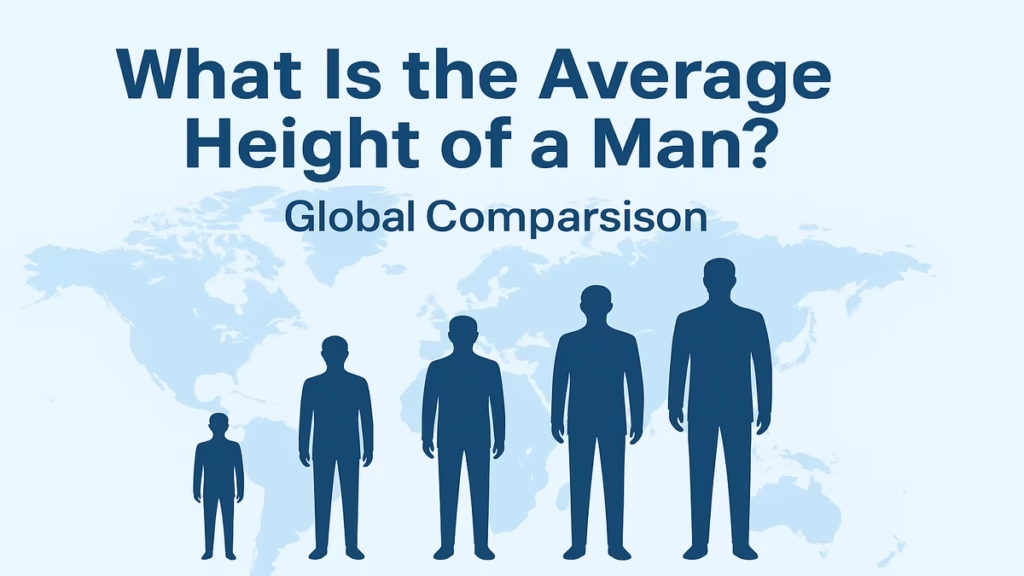When people ask, “what is the average height of a man?”, the answer isn’t as straightforward as a single number. Male height varies depending on factors such as genetics, nutrition, geography, and lifestyle. Still, knowing the average height for men worldwide gives us a fascinating look at human growth, health, and evolution.
In this blog, we’ll break down global averages, regional differences, factors influencing height, and answer popular questions like “what is the average size of a man?”.
Why Average Height Matters
Height is more than just a physical attribute—it’s linked to health, lifestyle, and even culture. Researchers often study the average height for men because it reflects:
- Nutrition levels in childhood and adolescence.
- Access to healthcare during growth years.
- Genetic patterns across populations.
- Environmental conditions such as climate and living standards.
For example, taller average heights are often seen in countries with high living standards, while malnutrition or poor healthcare can limit growth potential.
Global Average Height for Men
So, what is the average height of a man worldwide?
According to global health studies, the worldwide average height for men is about 5 feet 7 inches (170 cm). However, this varies significantly by country.
Here’s a quick overview:
| Country | Average Male Height |
|---|---|
| Netherlands | 6 ft (183 cm) |
| Denmark | 5 ft 11 in (181 cm) |
| Germany | 5 ft 10 in (179 cm) |
| USA | 5 ft 9 in (175 cm) |
| UK | 5 ft 9 in (175 cm) |
| India | 5 ft 8 in (173 cm) |
| China | 5 ft 7 in (171 cm) |
| Japan | 5 ft 7 in (171 cm) |
| Philippines | 5 ft 4 in (163 cm) |
As you can see, northern European men are among the tallest in the world, while Southeast Asian nations often record shorter averages.
Factors That Affect Male Height
Several factors contribute to differences in male height:
1. Genetics
Height is largely hereditary. If both parents are tall, chances are their children will be tall too.
2. Nutrition
Childhood nutrition plays a major role. Protein, calcium, and vitamins are essential for proper bone growth.
3. Geography
Altitude, climate, and even sunlight exposure (which affects Vitamin D levels) can influence height.
4. Health and Lifestyle
Chronic illnesses or hormonal imbalances can affect growth. Regular exercise, on the other hand, supports stronger bones and better posture.
What Is the Average Size of a Man?
While many people focus on height, the phrase “what is the average size of a man” also refers to weight and body build.
Globally, the average male weight is around 70–77 kg (154–170 lbs) depending on the country. Combining height and weight gives us the Body Mass Index (BMI), a common health indicator.
For example:
- A man with 175 cm height and 72 kg weight has a BMI of 23.5, which falls within the “normal” range.
Average Height of a Man by Region
North America
- USA: The average height for men is about 5 ft 9 in (175 cm).
- Canada: Similar to the US, around 5 ft 9 in (176 cm).
Europe
- Northern Europe (Netherlands, Denmark, Norway): Among the tallest men globally, averaging 5 ft 11 in – 6 ft.
- Southern Europe (Spain, Italy, Portugal): Slightly shorter, around 5 ft 8 in – 5 ft 9 in.
Asia
- East Asia (China, Japan, South Korea): Between 5 ft 7 in – 5 ft 9 in.
- South Asia (India, Pakistan, Bangladesh): Typically shorter, averaging 5 ft 6 in – 5 ft 8 in.
Africa
- Heights vary widely across Africa, with averages ranging from 5 ft 6 in – 5 ft 10 in.
Latin America
- Countries like Brazil and Mexico report average male heights between 5 ft 7 in – 5 ft 8 in.
Fun Facts About Male Height
- The tallest average male height is in the Netherlands (183 cm).
- The shortest average male height is found in Southeast Asia and parts of Central America.
- Over the last century, the average height for men has increased globally due to better nutrition and healthcare.
- Height can still change slightly into early adulthood, but most men stop growing around age 18–21.
Height and Health: Is Taller Always Better?
Being tall isn’t always an advantage. Research suggests:
- Taller men may have a lower risk of heart disease but a slightly higher risk of certain cancers.
- Shorter men may live slightly longer on average due to lower metabolic strain.
In other words, height is not a direct measure of health. Lifestyle, diet, and exercise matter more.
Tips to Improve Growth in Adolescence
If you’re still in your teenage years and wondering “can I increase my height?”, here are some tips:
- Eat a balanced diet with protein, calcium, and Vitamin D.
- Get regular exercise (swimming, basketball, and stretching help).
- Maintain good sleep habits (growth hormone is released during sleep).
- Practice good posture to maximize your natural height.
FAQs on Average Male Height
1. What is the average height of a man in the USA?
About 5 ft 9 in (175 cm).
2. Who are the tallest men in the world?
The Dutch, with an average height of 6 ft (183 cm).
3. What is the average size of a man in terms of weight?
Around 70–77 kg (154–170 lbs), depending on region.
4. Has the average height for men changed over time?
Yes, most populations have grown taller in the last century due to improved nutrition.
5. Does height stop increasing after 18?
For most men, yes. Growth plates close around ages 18–21.
Conclusion
So, what is the average height of a man? Globally, it’s around 5 ft 7 in (170 cm), but the number varies across regions. While genetics play a key role, factors like nutrition and lifestyle also matter.
Whether you’re tall, short, or somewhere in between, remember that health, confidence, and lifestyle are more important than height.







